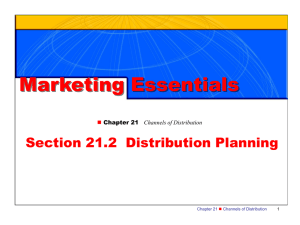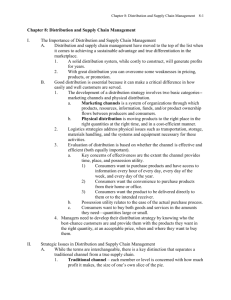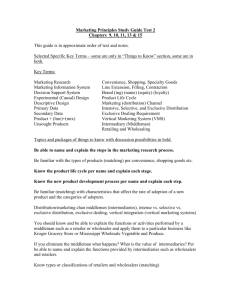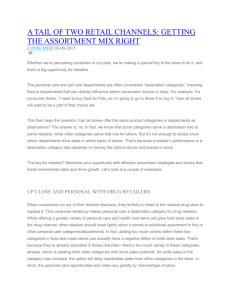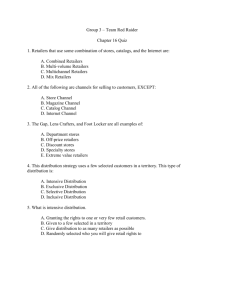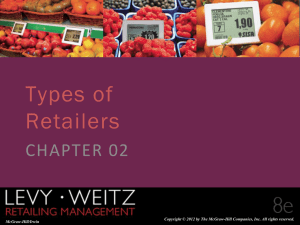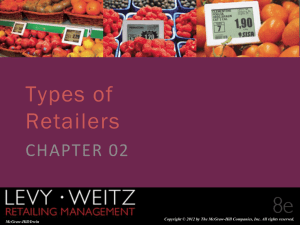Chapter 16 Quiz Group 1 1) Which is a factor in choosing retailing
advertisement
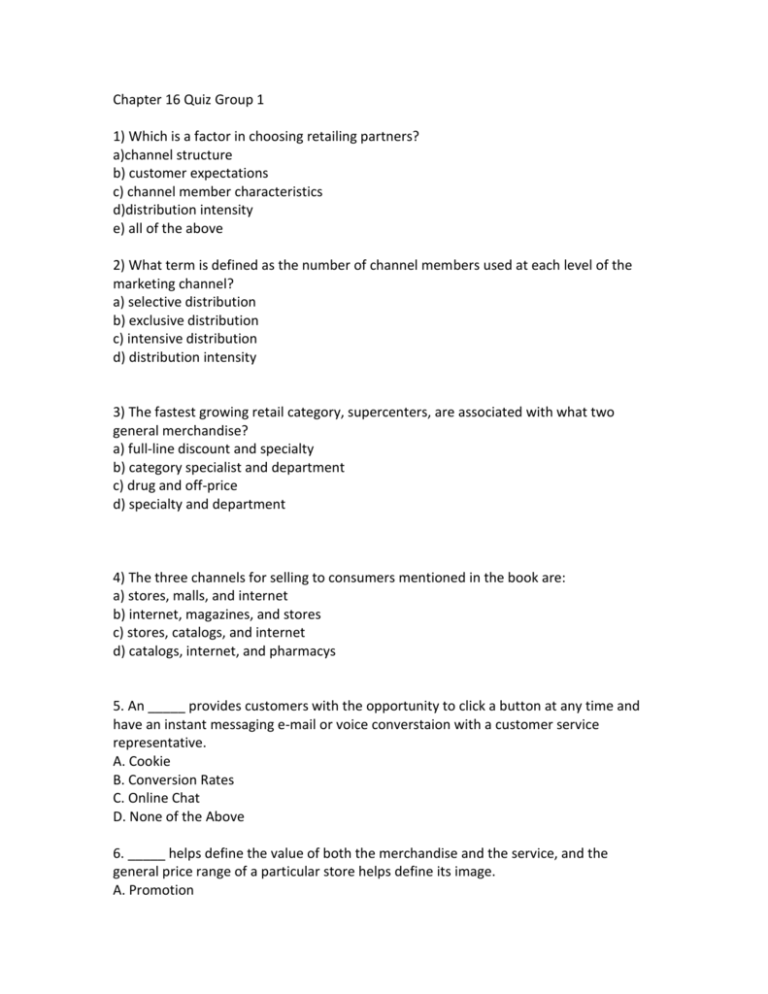
Chapter 16 Quiz Group 1 1) Which is a factor in choosing retailing partners? a)channel structure b) customer expectations c) channel member characteristics d)distribution intensity e) all of the above 2) What term is defined as the number of channel members used at each level of the marketing channel? a) selective distribution b) exclusive distribution c) intensive distribution d) distribution intensity 3) The fastest growing retail category, supercenters, are associated with what two general merchandise? a) full-line discount and specialty b) category specialist and department c) drug and off-price d) specialty and department 4) The three channels for selling to consumers mentioned in the book are: a) stores, malls, and internet b) internet, magazines, and stores c) stores, catalogs, and internet d) catalogs, internet, and pharmacys 5. An _____ provides customers with the opportunity to click a button at any time and have an instant messaging e-mail or voice converstaion with a customer service representative. A. Cookie B. Conversion Rates C. Online Chat D. None of the Above 6. _____ helps define the value of both the merchandise and the service, and the general price range of a particular store helps define its image. A. Promotion B. Price C. Product D. Place 7. Off-price retailers are also known as what? A. Open-out Retailers B. Close-out Retailers C. Irregulars D. Regulars 8. _____ are specialty stores that concentrate on pharmaceuticals and health and personal grooming merchandise. A. Liquor Stores B. Clothing Stores C. Drugstores D. Grocery Stores 9. By teaming up with Nordstrom to create promotions and advertising for their new line of eyeshadows M.A.C is participating in what? A. Dual-Advertising B. Double Promotion Strategies C. Share of Wallet D. Co-op Advertising 10. The percentage of consumers who purchase a product after viewing is referred to as what? A. Purchasing Population B. Distribution Intensity C. Conversion Rate D. Consumer Rate 11. JCPenney who uses stores, catalogs, and the internet to sell merchandise is known as a ___________? A. Multi-Channel Retailer B. Diverse Distributer C. Fortune 500 Company D. Category Specialist 12. A conventional supermarket stocks about 30,000 SKUs where as a _________________ only stocks about 2,000 SKUs. A. Supercenter B. Limited Assortment Supermarket C. Exclusive Retailer D. Convenience Store 1. If a company wants to get their product into as many outlets as possible they would use which strategy? a. Intensive Distribution b. Exclusive Distribution c. Selective Distribution d. All of the Above 2. What is the fastest growing retail category? a. Warehouses b. Supercenters c. Supermarkets d. Convenience 3. The internet benefits consumers by? a. Broader selection b. More information c. Personalization d. All the above 4. Retailers that use a combination of stores, catalogs and the internet are considered? a. Combination retailers b. Multichannel retailers c. Conversion retailers d. Inconsistent retailers 1) Which of the following is not a level of distribution intensity? a) Basic b) Intensive c) Selective d) Exclusive 2) Which is the fastest growing retail category that combines a supermarket with a discount store? a) Supermarket b) Warehouse club c) Supercenter d) Convenience store 3) Which is not a channel of distribution discussed in the chapter? a) Store b) Commercial c) Internet d) Catalog 4) People who participate in virtual communities are known as a) Virtual shoppers b) Everyday shoppers c) Exclusive shoppers d) Social shoppers Answer Key: 1. E 2. D 3. B 4. C 5. C 6. B 7. B 8. C 9. D 10.C 11.A 12.B 13.A 14.B 15.D 16.B 17.A 18.C 19.B 20.D





